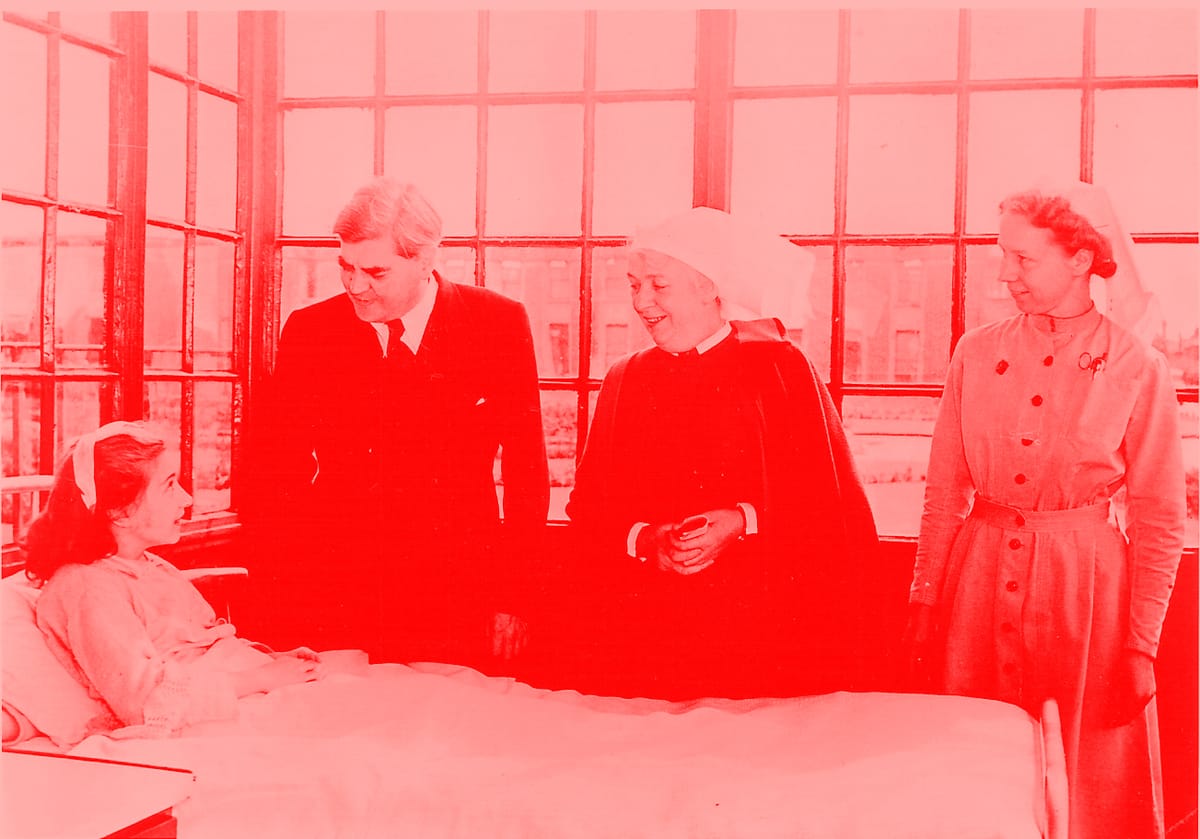Nationalization Took Time
It took a few decades for a truly national approach to health services to emerge after the creation of the National Health Service in Britain. The NHS produced a bevy of medical infrastructure just as the political forces to dismantle it were gaining strength.

Editor's note: Damage Issue 1: Building Big Things features multiple "Then" and "Now" vignettes. This article is one of the former; its companion, "Olympian Contradictions," can be found here.
The creation of the National Health Service (or, much more commonly for Brits, “our NHS”), both as an idea and as the physical infrastructure of hospitals, surgeries, and clinics, is one of the most familiar components of something approaching British national pride. At its launch in July 1948, Aneurin Bevan, the Health Secretary of Clement Attlee’s post-war Labour government, laid out its core: the country’s municipal and voluntary hospitals would be nationally owned, central to a health service that met the needs of everyone, was free at the point of delivery, and was based on clinical need instead of the ability to pay. The aspiration for a universal approach to healthcare was identified in the 1942 Beveridge Report that laid out the blueprint for Britain’s post-war welfare state. With a “Cromwellian spirit” that the author’s wife suggested be added to a first draft packed with typical bureaucratic language, the report called on Britons to band together to slay the “Five Giant Evils” of Squalor, Ignorance, Want, Idleness, and—through the NHS—Disease.
The immediate task for the NHS was the taking into common ownership of an existing network of private hospitals. As the political historian Richard Tuck points out, this expropriation is much celebrated by the British Left but would have been impossible in recent decades, since the nationalization-without-compensation of the old hospital trusts that the Attlee government undertook would have been prevented by the European Court of Human Rights. Even at the time, and for decades afterwards, there were large swathes of medical opinion against nationalization—though the political position of (particularly younger) doctors today is, on this issue at least, strikingly reversed.
Indeed, as British historian David Edgerton points out in his 2018 history The Rise and Fall of the British Nation, hospital building only started in the late 1950s, and got a major increase in the 1960s under the Tories. In reality, the hospitals and medical equipment of the 1950s were largely leftovers from the 1930s, and even in 1955 hospital building remained at a fraction of the interwar rate. One of the key events in the actual building of hospitals was the Hospital Plan for England and Wales under Health Minister Enoch Powell, which planned one new District General Hospital (DGH) per 125,000 people over the coming decade. The DGH was to be the core unit of hospital care, replacing the patchwork of hospital services and voluntary hospitals (run by local authorities and charities) that the NHS nationalized previously. With 600-800 beds each, Accident and Emergency (A&E) and Outpatient departments in a single site, close to population centers, and accessible by public transport, the DGH was modernized hospital care within the NHS. The Hospital Plan built 90 wholly new hospitals and refurbished 134 during the 1960s—a Herculean effort compared to contemporary infrastructure projects.
The NHS remains one of the symbols of the welfare state that working-class sacrifice in two closely following wars is said to have enabled. In reality, however, the hospital building project of the NHS only began in the 1960s and reached its height only a few short years before the neoliberal counter-revolution that would seek to dismantle it. Indeed, as Edgerton observes, a truly national approach to health services only emerged with a thoroughgoing reorganization of the NHS as late as 1974, bringing the hospitals built or revitalized during the 1960s into a national model. The “then” of NHS hospital building is closer in time to the “now” than many would probably assume.
■
George Hoare’s latest book is Taking Control: Sovereignty and Democracy After Brexit.



